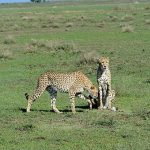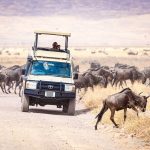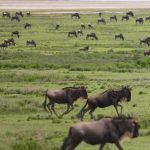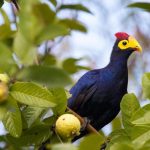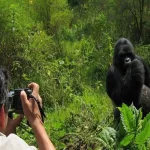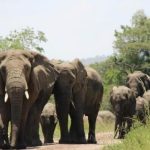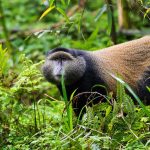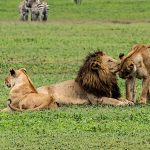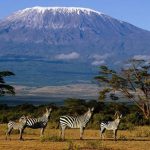Tarangire national park is one of the several natural habitats located in the great northern biodiversity conservation area of Tanzania. To be specific, Tarangire lies within the Manyara region, south of Arusha. This natural property derives its name from the Tarangire river that dissects it. The Tarangire River is the main source of water for wild mammals in the park, especially in the dry season.
Tarangire national park covers a total surface area of 2,850 square kilometres, making it the sixth-largest national park in the country. Its terrain consists of river valleys, ridges and swamps covered by combretum woodland, baobab trees, acacia woodland and seasonally flooded grassland. The naturally designed expanses, make the park the perfect habitat for most of the African exotic animals.
The Tarangire ecosystem is characterised by the long haul migration of the wildebeest and zebras, especially in the annual dry seasons. These ungulates move from as far as the dry Serengeti plains to inhabit around river Tarangire which is one of the few sources of water in the region during the dry spells of the year.
The park is also known for its colossal population of elephants and high density of baobab trees. The oldest elephant to have given birth to twins is a resident in Tarangire. Other wild animals commonly found in the park include the cape buffaloes, giraffes, waterbuck, dik-dik, eland, impala, lions, leopards, cheetahs, and African wild dogs and dik-dik to mention but a few. The white giraffe what spotted in the park in 2015 which was due to a rare disease of leucism.
Tarangire national park is also home to over 550 bird species and some of the birds are endemic to Tanzania. This makes it one of the best places for birding expeditions in Africa. The park has termite mounds that make up the terrain. The mounds which are no longer occupied by the termites become habitats for dwarf mongooses.
The park is famous for its high density of elephants and baobab trees. Visitors to the park during June to November dry season can expect to see large herds of thousands of zebra, wildebeest and cape buffalo. Other common resident animals include waterbuck, giraffe, dik-dik, impala, eland, Grant’s gazelle, vervet monkey, banded mongoose, and olive baboon. Predators in Tarangire include lion, leopard, cheetah, caracal, honey badger, and African wild dog.
Tarangire national park became a lion conservation area in 2005 and wildlife research is also carried out on Massai giraffes and African bush elephants in the park.
Accessibility
Tarangire national park is located southeast of Arusha where Kilimanjaro international airport is situated. The travel distance between the two places is about 150kms, 3hours’ drive.
For visitors coming from Lake Manyara national park, the travel distance to Tarangire is 70 kilometres.
We advised travellers to use a local tour operator to arrange a 4×4 rental car to lead them to the park.
Popular activities to do in Tarangire National Park
- Game drives
Without a doubt, game viewing is the most conducted tourism activity in Tarangire national park. The park has grassland expanses that open up opportunities for encountering exotic animals like elephants, zebras, lions, hyenas, wild dogs, cheetahs, elands, wildebeests, impalas, buffaloes and kudus among others. Savannah birds like kori bustard, yellow collared lovebirds and ostriches are seen on a game drive.
Tourists who are interested in witnessing the migration of Wildebeest and zebra from the Serengeti to the Tarangire ecosystem are advised to visit the park during the dry spell between July to November. There are three game drive sessions carried out in the park, namely the early morning game drive, the afternoon and evening and the night game drive. The Night game drive exposes tourists to nocturnal animals like leopards, bush babies and hyenas.
The best trails to unfold most of the exotic animals in the park on the game drive are Kitibong, western Lake Barungi, Gursi, Lamarku and Lemiyon.
Game drive in Tarangire is best done by using a 4×4 open roof or pop up roof safari vehicle led by an experienced and well-trained guide.
- Bird watching
Having over 550 bird species recorded in its territories, Tarangire national park is one of the best birding spots in Tanzania. The bird species range from tropical birds to water birds, and migratory and endemic birds. Birders are advised to hire an experienced bird guide around the park or arranged by your local tour operators to have an insightful and remarkable birding expedition in the park. The birds are perfectly sighted on a walking safari and the birds to see include ashy starling, helmeted guinea fowl, tiny pygmy falcon, giant lappet-faced vulture, yellow collared lovebirds, rufous tailed weaver and many more.
- Walking safaris
The walking safaris take place in the southern section of the park. The nature walks enable tourists to immerse their senses in the experience of exploring the African bushes on foot. The walking safaris are normally organised by the camps or lodges around the southern region of the park. The southern region is not that busy and has fewer predators hence being a great place for nature walks. However, for precaution, the visitors are accompanied by an armed park ranger during the walking safaris. Innumerable wildlife species are encountered up-close and personal on the walking safari, for example; elephants, buffaloes, giraffes, giraffes, elands, impalas and a variety of bird species.
- Cultural tours
The dominant race of people in the northern dry region of Tanzania where Tarangire national park is located is the Maasai. The Maasai people are some of the indigenous people to have settled in East Africa. These people have stuck to their culture and ethos. They are renowned cattle keepers and have an interesting way of dressing. Their attires are colourful and eye-catching. To embrace and know more about them is by visiting their homesteads, tasting their foods, engaging in their routine activities of making the colourful attires and crafts and enjoying their traditional performances.
Best time to visit Tarangire national park
The Tarangire national park is open to visitors throughout the year. However, the touring of the park is influenced by the two climatic conditions experienced annually, the dry and wet seasons. The dry season comprises the months of January, February, March, June, July, August, September, October and December and the wet season includes April, May and November Many travellers prefer the dry months and consider them the best time to visit Tarangire national park. in the dry season, the terrain and the roads leading and within the park are dry rendering easy accessibility and convenient engagement in the park activities like game drives and walking safaris. The dry spell is also when the great migration of the wildebeests and zebra takes place from the Serengeti plains to the Tarangire ecosystem. In addition, the days are bright enhancing photography and videography which is the main motive why tourists come to the park.
Although the wet season, the months of April, May and November come with adversaries like muddy, sloppy and impassable roads, it has some advantages. For instance, the national park is not congested by tourists, offering a private and secluded experience. The plains are green and the animals are healthy and beautiful to look at.
The wet season is the period when migratory birds from Europe and North Africa come to the Tarangire plains.
Safari lodges in Tarangire National Park Tanzania
Tarangire National park has luxury tent camps, bandas, campsites, eco and grass-thatched roof safari lodges for its visitors to stay in. The tourists have a choice to select the best suitable accommodation establishment to stay in with the help and advice of the tour consultant or organiser. The traveller’s favourite lodges include Tarangire Simba Lodge, Tarangire Sopa Lodge, Lemala Mpingo Ridge Lodge, Nyikani Tarangire Camp, Baobab Tented Camp, and many others.

